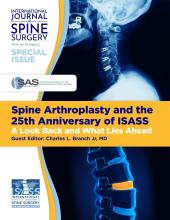- minimally invasive spine surgery
- technology
- lumbar spine
- cervical spine
- patient safety
- clinical outcomes
- endoscopy
- interbody fusion
Spine surgery has changed drastically over the past half century, with surgeons increasingly using—and patients increasingly expecting—minimally invasive approaches that will speed recovery and improve patient outcomes. Considering the rapidly changing landscape of spine surgery and the introduction of new technologies, it can be difficult for practicing spine surgeons to keep abreast of the various options in minimally invasive spine surgery. With this in mind, this special issue of the International Journal of Spine Surgery sought contributions from some of the masters in minimally invasive spine surgery, and they have provided truly detailed technical manuscripts, complete with perioperative photographs, clinical tips, and pearls of wisdom, for the practicing spine surgeon.
Each manuscript is a detailed description of how the author and his team technically handle a particular surgical case and execute to perfection. Senior author Frank Phillips describes his team’s approach to preoperative imaging, patient positioning, and surgical technique in lateral transpsoas interbody fusion while emphasizing patient safety and evidence-based decision-making. Juan Uribe and colleagues provide a technical guide to the prone lateral transpsoas approach to the spine, highlighting key strategies in the preoperative workup, patient selection, and operative techniques to optimize workflow. Michael Wang and his team review the major techniques in transforaminal lumbar interbody fusion, while Choll Kim focuses on endoscopic approaches for the lumbar spine. Dr Kim includes links to his lumbar endoscopic spine surgery checklists, which are the ultimate tools in preoperative preparation. Finally, with my coauthors, I present the SIMPLER (Segmental Interbody, Muscle-Preserving, Ligamentotaxis-Enable Reduction) technique in the correction of adult spinal deformity. This technique uses circumferential minimally invasive surgery without an osteotomy.
In current literature, it is rare to see such detailed technical manuscripts. I hope that these articles will shed light on these surgical masters’ trade to the benefit of all our readers around the world, as well as to the benefit of our patients.
Footnotes
Funding The author received no financial support for the research, authorship, and/or publication of this article.
Declaration of Conflicting Interests The author reports no conflicts of interest in this work.
Disclosures Consultant (Medtronic Globus Medical, Spinal Balance, Viseon, Spinal Elements, Carlsmed, Orthofix/Seaspine, and On-Point Surgical), royalties (Medtronic, Globus Medical, and Elsevier), SAB (Spinal Balance, Cerapedics), editor/advisor (Gray's Anatomy), and stocks/stock options (Medtronic, Globus Medical, J&J, SI Bone, Orthofix, Paradigm Spine, ISTO Surgical, AF Cell, Bonovo, Atlas Spine, Spinal Balance, Spinal Simplicity, Viseon, and On-Point Surgical).
- This manuscript is generously published free of charge by ISASS, the International Society for the Advancement of Spine Surgery. Copyright © 2025 ISASS. To see more or order reprints or permissions, see http://ijssurgery.com.







